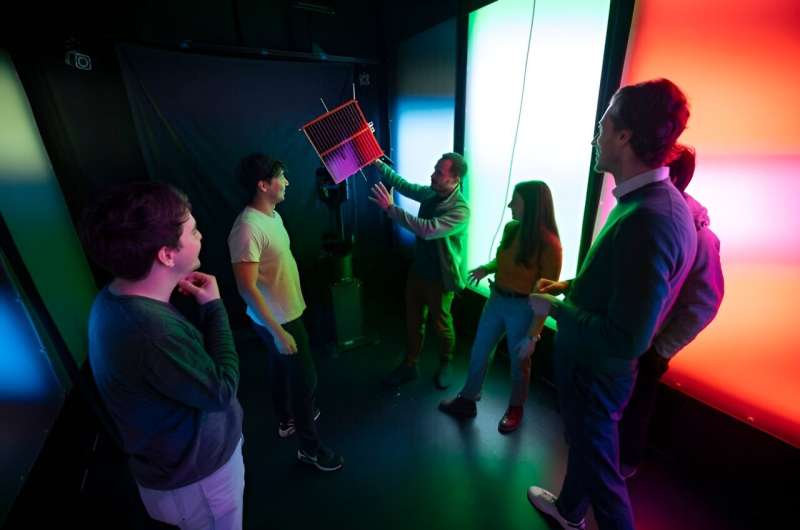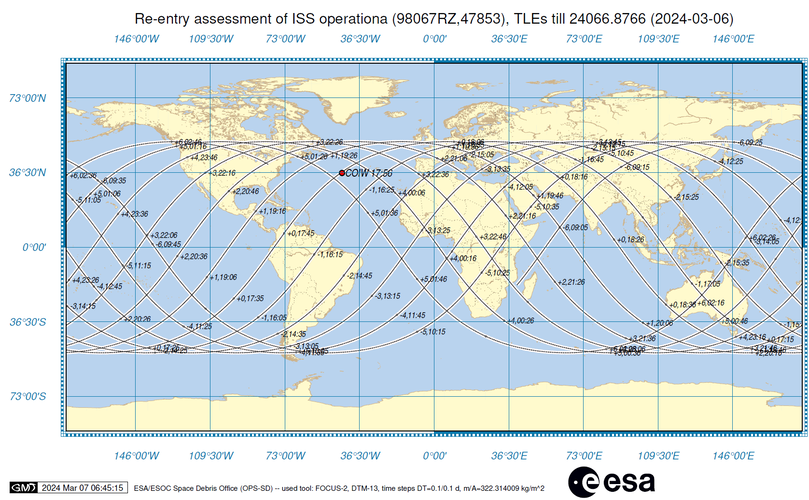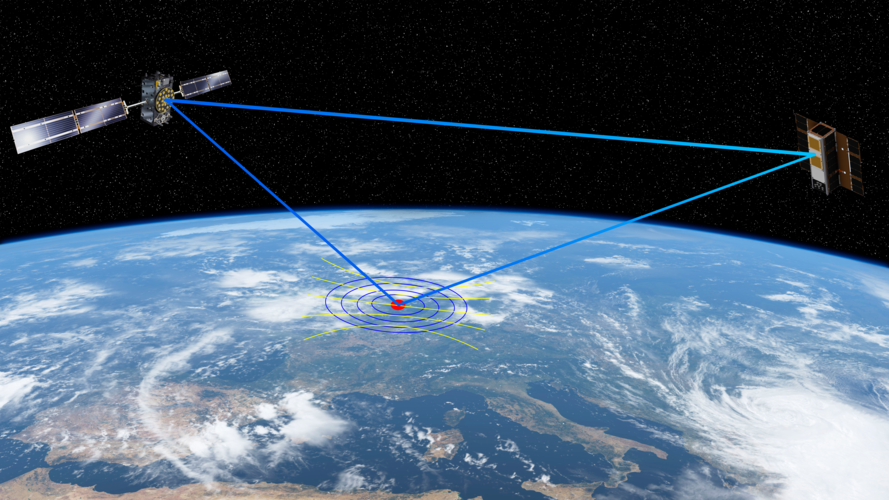
Copernical Team
AI makes a rendezvous in space

Space travel is complex, expensive, and risky. Great sums and valuable payloads are on the line every time one spacecraft docks with another. One slip and a billion-dollar mission could be lost. Aerospace engineers believe that autonomous control, like the sort guiding many cars down the road today, could vastly improve mission safety, but the complexity of the mathematics required for error-free certainty is beyond anything on-board computers can currently handle.
In a new paper presented at the IEEE Aerospace Conference in March 2024 and published on the preprint server arXiv, a team of aerospace engineers at Stanford University reported using AI to speed the planning of optimal and safe trajectories between two or more docking spacecraft.
Reentry of International Space Station (ISS) batteries into Earth’s atmosphere

New radar mission for Europe
 Video:
00:09:27
Video:
00:09:27
The upcoming Copernicus Radar Observation System for Europe in L-band (ROSE-L) will provide continuous day-and-night all-weather monitoring of Earth’s land, oceans and ice, and offer frequent observations of Earth’s surface at a high spatial resolution.
ROSE-L will carry an active phased array synthetic aperture radar instrument. The radar antenna will be the largest deployable planar antenna ever built measuring an impressive 40 sq m.
ROSE-L will deliver many benefits including essential information on forests and land cover, leading to improved monitoring of the terrestrial carbon cycle and carbon accounting.
The mission will also greatly extend our ability to monitor minute
Icy first light of shoebox-sized PRETTY CubeSat

A shoebox-sized satellite looking far to the horizon picked up a strong signal reflection from hundreds of kilometres below it, beside a lonely polar island in the Canadian Arctic. ESA’s PRETTY CubeSat mission team could not be quite certain of what its instrument first light was showing until cross-checking it against a Sentinel-1 radar map of the same location, to find a precise correlation with a stretch of offshore sea ice.
UMaine researchers use GPS-tracked icebergs in novel study to improve climate models
 Over the last four decades, warming climate and ocean temperatures have rapidly altered the Greenland Ice Sheet, creating concern for marine ecosystems and weather patterns worldwide. The environment has challenged scientists in their attempts to measure how water moves around and melts the ice sheet because equipment can be destroyed by icebergs floating near the glaciers.
Collected using
Over the last four decades, warming climate and ocean temperatures have rapidly altered the Greenland Ice Sheet, creating concern for marine ecosystems and weather patterns worldwide. The environment has challenged scientists in their attempts to measure how water moves around and melts the ice sheet because equipment can be destroyed by icebergs floating near the glaciers.
Collected using GITAI tests robotic construction of lunar comms tower in desert simulation exercise
 GITAI USA Inc. (GITAI), a leader in space robotics innovation, has successfully showcased its advanced robotics technology through the construction of a 5-meter-high communication tower. This achievement was realized in a desert environment meticulously designed to simulate the lunar surface, representing a "first of its kind" demonstration in space robotics.
GITAI, in a collaborative effo
GITAI USA Inc. (GITAI), a leader in space robotics innovation, has successfully showcased its advanced robotics technology through the construction of a 5-meter-high communication tower. This achievement was realized in a desert environment meticulously designed to simulate the lunar surface, representing a "first of its kind" demonstration in space robotics.
GITAI, in a collaborative effo Teledyne e2v HiRel Unveils New S-Band Ultra-Low Noise Amplifier for Space Missions
 Teledyne e2v HiRel has announced the launch of its latest product - the TDLNA2050SEP, a radiation-tolerant S-Band low noise amplifier. This product stands out in the market for its exceptional performance tailored to meet the rigorous demands of space and radar applications, where every component's reliability, efficiency, and size play a critical role in the success of the mission.
Develo
Teledyne e2v HiRel has announced the launch of its latest product - the TDLNA2050SEP, a radiation-tolerant S-Band low noise amplifier. This product stands out in the market for its exceptional performance tailored to meet the rigorous demands of space and radar applications, where every component's reliability, efficiency, and size play a critical role in the success of the mission.
Develo Full Disclousre: Enhanced Radiation Warnings for Space Tourists
 In a groundbreaking study led by space weather experts at the University of Surrey, there's a growing call for immediate action to safeguard the burgeoning space tourism industry from the invisible threat of cosmic radiation. The study, recently published in Space Policy, emphasizes the urgent need for collaboration between regulators and space tourism companies to enhance passenger and crew pro
In a groundbreaking study led by space weather experts at the University of Surrey, there's a growing call for immediate action to safeguard the burgeoning space tourism industry from the invisible threat of cosmic radiation. The study, recently published in Space Policy, emphasizes the urgent need for collaboration between regulators and space tourism companies to enhance passenger and crew pro NASA tests limits of updated engines for future Artemis missions
 NASA completed a full-duration RS-25 engine hot fire Wednesday, as the space agency continues testing the updated engines that will launch Artemis missions to the moon and beyond.
The full-duration test was the ninth of 12 scheduled tests, and took place on the Fred Haise Test Stand at NASA's Stennis Space Center near Bay St. Louis in Mississippi.
The certification engine, which
NASA completed a full-duration RS-25 engine hot fire Wednesday, as the space agency continues testing the updated engines that will launch Artemis missions to the moon and beyond.
The full-duration test was the ninth of 12 scheduled tests, and took place on the Fred Haise Test Stand at NASA's Stennis Space Center near Bay St. Louis in Mississippi.
The certification engine, which First Arab woman to graduate NASA training shoots for the Moon
 Like her ancestors before her, Emirati astronaut Nora AlMatrooshi has spent much of her life gazing up at the stars and dreaming of flying to the Moon.
This week, she became the first Arab woman to graduate from NASA's training program, ready to blast off into the cosmos.
AlMatrooshi, 30, remembers an elementary school lesson about space in which her teacher simulated a trip to the lu
Like her ancestors before her, Emirati astronaut Nora AlMatrooshi has spent much of her life gazing up at the stars and dreaming of flying to the Moon.
This week, she became the first Arab woman to graduate from NASA's training program, ready to blast off into the cosmos.
AlMatrooshi, 30, remembers an elementary school lesson about space in which her teacher simulated a trip to the lu 